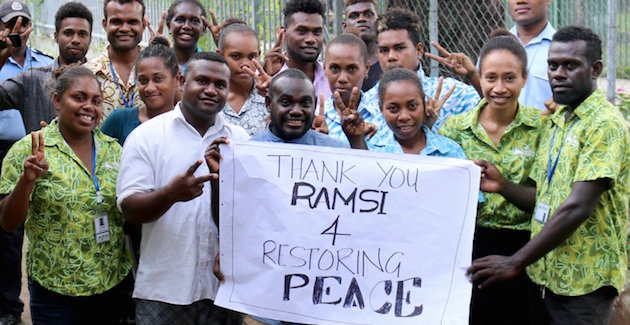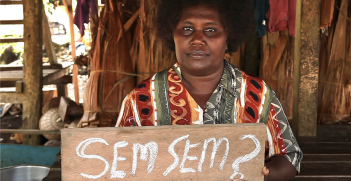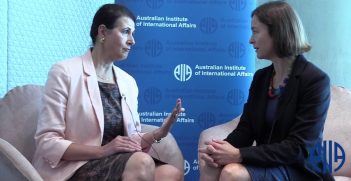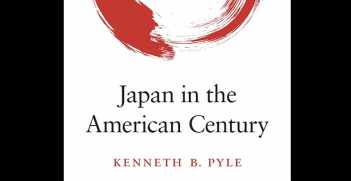Uncertainty Grows in Post-RAMSI Solomon Islands

The end of RAMSI signifies a new phase in the Solomon Islands’ post-conflict journey, one in which reconciliation and development remain key challenges. But after 14 years, Solomon Islanders are sceptical about the country’s capacity to continue reform without international assistance.
On June 30, The Regional Assistance Mission to Solomon Islands (RAMSI) officially came to the end of its 14-year engagement. Deployed in 2003, following a request for assistance from the Solomon Islands Government, RAMSI was an ambitious and expensive endeavour for the region and in particular for Australia. Indeed, over the course of the mission Australia invested approximately $2.8 billion dollars and contributed thousands of military and policy personnel.
While the Australian delegation coordinated and led the intervention, RAMSI also represents a uniquely coordinated regional response, with contributions from 14 other members of the Pacific Islands Forum. These nations provided military and police, advisors and diplomats to the rebuilding process. In addition, RAMSI was subject to a wide range of regionally-coordinated oversight mechanisms. This distinctly regional character, coupled with the invitation from the local government, gave RAMSI its legitimacy and was a significant factor in ensuring its longevity and sustained engagement. In this respect, the initiative set a new benchmark for regional cooperation with respect to intervention, as it was the first regional partnership of this nature and scale.
Initially formed to bring an end to the violence that had plagued the country since 1998, RAMSI also took up an ambitious state-building mandate. That is, its objectives included a range of initiatives designed to assist the Solomon Islands community in navigating the complexity associated with rebuilding failing and inefficient institutions. This involved the coordination and implementation of practices that would renew the country’s financial and judicial infrastructure, whilst developing the capacity of Solomon Islanders. In addition, the mission sought to rebuild the trust of the Solomon Islands people in their government and its institutions.
RAMSI’s success in fulfilling these objectives has received mixed reviews, particularly from those living outside the capital city of Honiara whom have yet to reap significant benefits from the country’s revitalised institutions. Whilst peace has been restored, addressing the underlying causes of the conflict through development and reconciliation reforms is just beginning. Indeed, the community grows increasingly sceptical regarding the capacity of these institutions to implement the necessary reforms without significant international assistance.
The institutions of the Solomon Islands and their local agents, therefore, face the daunting task of operating independently to accommodate the constantly-evolving development needs of a diverse Solomon Islands community. Yet the withdrawal of RAMSI raises questions about the capacity of the Solomon Islands to reclaim full control of its institutions, and to continue pursuing its complex reconciliation and development agenda.
Today represents a critical juncture between the past and the future for the Solomon Islands. While the country begins to grapple with this new phase of independent governance, it must be mindful of the grievances of the past, and the need to continue the commitment to confront those grievances left unresolved.
Challenges ahead
Whilst RAMSI played an important caretaker role, helping to foster a peaceful environment in which the country’s institutions could evolve, successive Solomon Islands governments have failed to capitalise on this 14-year peace. Described by the country’s opposition leader as a “regional saviour,” the mission achieved a series of early successes before appearing to stall under the weight of an ambitious and, at times, piecemeal rebuilding process.
This has left Solomon Islanders wondering whether continued stability is possible, particularly as many of the root causes of “The Tensions” remain unresolved. In particular, frustrations over land rights and unchecked government corruption persist throughout the Solomon Islands.
Furthermore, there is growing concern about the government’s commitment to reconciliation given its reluctance to publicly acknowledge the findings of the Truth and Reconciliation Commission (TRC). Five years have passed since the government received the TRC report; however, participants have yet to receive any significant institutional recourse for the harms identified through this process. Amongst the most notable challenges still facing the Solomon Islands, therefore, are reconciliation and development.
The reconciliation process remains in limbo, as political, cultural and economic constraints have stalled the implementation of the TRC’s recommendations. Specifically, the contested notion of a national identity, coupled with the highly patronised political culture that persists throughout the Solomon Islands, has seen the reconciliation agenda relegated to a low priority on the national stage.
This is further evident in the lack of financial commitments to the implementation of these reforms in the years following its release to the government. Indeed, rather than the expected increase in spending on peace and reconciliation budgetary reports demonstrate a stark decline. Moreover, since the release of the final report, local leadership has embarked on multiple campaigns to manage expectations with respect to its financial capacity to implement all the recommended reforms. Regardless of the new challenges the Solomon Islands faces post-RAMSI, it is imperative that they follow through and complete this protracted reconciliation process. Indeed RAMSI’s success may well be determined by the capacity of Solomon Islanders to harness the lessons learnt during intervention to further their reconciliation agenda.
Efforts to elicit local ownership and broad community engagement were lacklustre as the process often neglected the history and cultural diversity of the provinces. Indeed, state-building initiatives relied on liberal notions of institutional effectiveness and the placement of foreign diplomats within these institutions. Consequently, progress rebuilding the capacity and efficiency of these institutions has seen mixed results, leaving locals doubting their sustainability and legitimacy.
Questions persist over whether the institutions rebuilt during the RAMSI-era are capable of operating independently. The true measure of their capacity, however, will be in their ability to evolve in a manner that reflects the diversity of the Solomon Islands whilst maintaining the transparency of liberal institutions.
This is not to suggest, however, that reconciliation and development efforts have been completely abandoned. As recently as June 2017, the Sogavare government reaffirmed its commitment to reconciliation, highlighting the symbiotic relationship between peace and the country’s continued growth and prosperity. Given this, only time will tell if this commitment is more rhetoric than reality.
Furthermore, it remains unclear if the current work on sequencing and prioritising these recommendations will translate into actual programs and policies. What is clear, however, is that steady progress and leadership on the reconciliation and development agenda will resolve any doubts that remain regarding the capacity of the Solomon Islands to maintain the stability and peace of the RAMSI era. The question remains, has RAMSI laid a solid foundation for Solomon Islanders to continue their post-conflict journey or has the protracted intervention unconsciously cultivated dependency?
Caitlin Mollica is a PhD candidate in the School of Government and International Relations at Griffith University. Her detailed research on the Solomon Islands Truth and Reconciliation Commission has been published in the Australian Journal of International Affairs.
This article is published under a Creative Commons Licence and may be republished with attribution.





